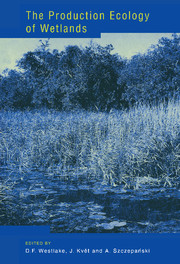Book contents
- Frontmatter
- Contents
- List of contributors
- Preface
- Foreword
- 1 General ecology of wetlands
- 2 Primary production in wetlands
- 3 Further fate of organic matter in wetlands
- 4 The role of decomposers in wetlands
- 5 The role of animals and animal communities in wetlands
- 6 Mineral economy and cycling of minerals in wetlands
- 7 Micro-climatic conditions and water economy of wetlands vegetation
- 8 The management of wetlands
- References
- Index
Preface
Published online by Cambridge University Press: 27 October 2009
- Frontmatter
- Contents
- List of contributors
- Preface
- Foreword
- 1 General ecology of wetlands
- 2 Primary production in wetlands
- 3 Further fate of organic matter in wetlands
- 4 The role of decomposers in wetlands
- 5 The role of animals and animal communities in wetlands
- 6 Mineral economy and cycling of minerals in wetlands
- 7 Micro-climatic conditions and water economy of wetlands vegetation
- 8 The management of wetlands
- References
- Index
Summary
This book has a long history, which dates back to the early days of the IBP. In 1965–66, when assessment and comparison of biological productivity was recognised as one of the main topics requiring study, plant ecologists proposed that a set of widespread plant species or genera should be selected as test plants. Their production and production processes could be compared, world-wide, in the widest possible range of habitats and experimental sites. Phragmites australis, a widely distributed wetland plant, was among those suggested. Many countries, research institutes and individual scientists participating in the IBP, within its PT (Production Terrestrial), PF (Production Freshwater) and PP (Production Processes) sections, took up this idea, and several started research, or modified their current research, on Phragmites. However, many other research programmes within the IBP took a different approach, often studying more local species and sites; and it was clear from the start that production by individual species, even if dominant, could only be understood in the context of whole communities and ecosystems. This resulted in a great variety of intensive studies of the littoral zones of water bodies and wetlands in general, particularly as examples of boundary ecosystems (ecotones).
The first opportunity to integrate these results with other research on higher submerged and emergent plants was at the International Conference on Aquatic Macrophytes, convened after an initiative by Romanian and Czechoslovakian specialists, and sponsored jointly by IBP and the UNESCO International Hydrological Decade.
- Type
- Chapter
- Information
- The Production Ecology of WetlandsThe IBP Synthesis, pp. xiii - xviiiPublisher: Cambridge University PressPrint publication year: 1999

